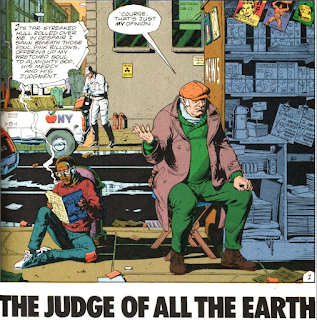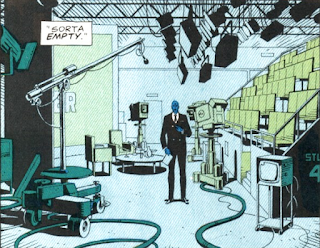"Reader, take comfort from this:
in Hell, at least the gulls are contented. "
in Hell, at least the gulls are contented. "
Not content with the impressive array of mirror-narratives already in play, Chapter Three of the Watchmen saga introduces two more: a news vendor and his young companion, and the pirate comic he's reading, Tales of the Black Freighter.
I'll save discussion of Tales until the Coda, though it's such an indelible part of the stories-to-come that it'll inevitably pop up here and there.
The news vendor and the kid reading the pirate-comic function mainly as man-in-the-street color commentary and conduit into the pirate comic, respectively. The other narrative(s) intersect with them in interesting ways, though, as we'll see down the line.
The action switches from the survivor-protagonist of the comic book, caressing the figurehead from the boat to which he clung during the shipwreck, to Jon, caressing Laurie's face at Rockefeller Military Research Center.
"The self-reflecting cross-referral of image and text reached fever pitch as Watchmen unfolded. A drawing of Doctor Manhattan telekinetically looping a tie around his neck for a rare clothed appearance in a TV interview has his estranged lover (...) ask in voiceover:
 |
| "While a scene in which she crushes a mugger’s balls in her grip is cross-cut with another character’s words to Doctor Manhattan:" |
"The parallel narrative threads of Manhattan and Laurie reflected and commented upon each other in a kind of remote quantum entanglement that perfectly suited Manhattan’s nature (and also) dramatized the breakdown of a relationship."
Everything connected in a dazzling, elaborate hall of narrative mirrors."
  |
| Relentless self-awareness aside: |
Laurie finally walks out on Jon directly before he leaves for his interview. They have, as noted above, been increasingly estranged of late.
When she discovers he split himself into three beings - two to go to bed with her and one to continue watching quarks stick to gluinos in his lab:
 |
| it's the final straw. |
She goes to Dan Dreiberg's house and unburdens herself.
 |
| If you know the way the comic ends, this panel is a bit of a wink. If not, it just seems the caption and the advertisement are mirroring one another. |
He asks her if she wants to come along for his weekly get-together with Hollis Mason, and she agrees. The action cuts back and forth between Jon being grilled by the studio audience about his former associates (and first love) all contracting cancer and Dan's and Laurie getting jumped on their way across town. The interview ends with Doctor Manhattan teleporting everyone away (to where we don't know) when they won't stop swarming him, demanding answers -
- while the attempted mugging comprises this chapter's showcase scene for the ongoing examination of sex and violence in comics.
The rest of the issue deals with the immediate fallout of Doctor Manhattan's sudden disappearance, namely the Soviet Union invading Afghanistan and President Nixon's meeting with Kissinger and his generals about both.
I love that "If he wanted to live on a Red planet, he should have stayed home" line. At the time, I admit, the full effect of Nixon's and Kissinger's appearance in this story went over my twelve-year-old head. I appreciate it now, of course, though I wouldn't mind a little more information on this level of the Tower where the Nixon/ Kissinger regime never went away on account of having the human H-bomb at their command. But, you can't have everything.
So many shots in this issue emphasize what the Comedian lamented in Chapter Two: the increasing alienation of Doctor Manhattan.
But it is not Laurie's leaving that is the catalyst for his removing himself to Mars; it is the mention of Janey Slater - his first love - and her dying from cancer. Although this will be revealed to be a precisely coordinated event, it nevertheless reconnects him to that quantum of humanity left in that swirl of quarks and leptons he calls a heart. All that comes later, of course, and is an arguable interpretation at best. For now, we see him start this journey, stopping in at Ground Zero to pick up this old photo of him and Janey before warping out to Mars.
I think Watchmen may have been the first comic to truly open my eyes to the role of the colorist in the whole comics-making process. Again, not when I was twelve but coming back to it later. John Higgins' work in these twelve issues is fantastic. He offers some commentary both on his craft and also personal recollections of working with Dave Gibbons and Alan Moore here. The garish-but-always-fascinating-and-consistent color design is as much an identifying feature of Watchmen as exaggerated light-and-shadow contrast is to film noir.
Like everything else in Watchmen, even the color design deconstructs the history of the medium itself:
"A very brief color history to all you who now can print in your own homes near perfect facsimiles of any color art you can imagine: In 1986 everything was done by hand. I colored the black and white copies of Dave's pages with watercolor, and then marked the equivalent printing ink combination for each color. So for Rorschach's brown overcoat it would be Y3M2C1. Then that page would be sent to hand separators who would do up to twelve separate acetate overlays for each page to create a four-color effect. (...) No matter how subtle I tried to be with the color, what I was trying to get from my mind to the printed page was getting confused before it had even been printed. Also we found early on when we had the new option of using tones of grey, we should not have used them on the first couple of issues, but this we unfortunately only found out once they had seen print!"
"I have had to live with all the mistakes, color conundrums and printing limitations on one of the most seminal graphic stories of the 20th century (...) What you see in the 2005 edition is what I had always intended the Watchmen color to be, but due to the printing limitations of the period you never saw it before. Believe me, (...) to finally get rid of the grey tone, to consolidate the color conundrums, to tie all the color threads into one united whole, was a joy."
(I changed all of his "colours" to "colors" for the benefit of my mostly-US audience. You're welcome, turkeys.)
Maybe the quote I chose isn't the best to illustrate how Watchmen's color design deconstructs the history of the medium. I'm of the opinion it does, though; I just lack the ability to describe it properly. Some host, I know! Feel free to raid the liquor cabinet.
I normally despise digital recoloring of any comics published before 1990. Probably because it almost always looks like this:
Consider the I-can't-even garishness of the above (from Fantastic Four Annual #1) to the digital recoloring in Absolute Watchmen (2005). Perhaps the trick is getting the original colorist to be in charge of the upgrade.
Granted the ones on the right are from the Motion Picture Comic, but the MPC used the digitally-recolored AW as its template. (I think Higgins might even have been a consultant on the MPC, but I'm not sure. See bad-host apologies above.)
No Hangin' with Mister Rorschach feature this time around, on account of his not being in the issue much.
 |
| Perhaps next time. |
~
See you in one month's time for Chapter Four - make sure to bring your anti-radiation meds.


































There's some kind of importance going on with that "quantum entanglement", I just don't for the life of me know what that is.
ReplyDeleteAnother interesting line is Silk Specter's line about how "...All the people are like shadows." Actually, their just a series of make-believe ideas, existing only in the minds of their creator, or whoever happens to be the audience at any given moment.
I could be wrong, yet I think Moore is asking what it is that makes people value not just "Watchman" or superheroes, but also fiction in general. I don't know if that's the facts of the case. However if that's what he's doing, then he just asked the mega-bucks lottery question. The interesting part is how I'm not sure most people would ever be able to find an adequate answer to the question. In some ways, this is just me, Moore is echoing certain speculations made by Philip K. Dick in "Man in the High Castle" in terms of the value or importance attached to various items or ideas in life.
There's a bit of Moore related news recently, whether or not it has anything to do with the discussion is for others to decide. "The Killing Joke" has been retconned.
For pertinent info see here:
http://www.ign.com/articles/2016/03/08/is-dc-changing-this-iconic-batman-story
And here:
http://www.comicosity.com/review-batgirl-49/
For whatever it's worth, I'll admit when I read the reports, I was hopeful. When I read the comic itself, I breathed a quiet sigh of relief. I always hated O'Neill's decision from the moment I found out about it. It's how I still feel about it, and I don't what that says, or how others will take it. Right now, I'm just glad it's been neutralized in some fashion, at least.
ChrisC
Honestly, hasn't the DC continuity been scrambled a hundred times between now and then? I'm surprised DC felt they even had to call attention to it.
DeleteI think Cameron Stewart is a great artist, but when it comes to Batgirl, for me she peaked in the 70s. That will always be the iconic version of the character for me. Batman in general, though of course I love all the iconic 80s stuff, even most of The Killing Joke. (But not the crippling Barbara Gordon part).
That John Higgins commentary is a good find. Cheers for that.
ReplyDeleteGlad you enjoyed. His linked-to remarks are worth reading in their entirety; I had to stop myself from quoting the whole thing.
DeleteExcellent Watchmen review. I haven't read Morrison's Supergods but I plan to. Some day I must write about Watchmen on my blog.
ReplyDeleteBy the way, just like I did last year I wanted to ask you a favor, I'm promoting my new comic, as you can see here:
http://artbyarion.blogspot.com/2016/03/buy-dawn-of-undead-now-and-win-marvel.html
It would mean a lot to me if you help me spread the link around, and even better yet, if you post something about this on your blog.
Thanks!
My work computer won't open your blogspot for some reason, I'll have to check when I'm home. Hope it does well, though, and glad to hear you enjoyed this entry.
DeleteI've got a copy of Absolute Watchmen, and not too long ago I bought surprisingly-affordable copies of the original twelve issues. I'd love to sit down with the two side by side someday and do a color comparison. It's fascinating -- and troubling -- to consider how compromised the quality of something like "Watchmen" can be due to an issue like that.
ReplyDeleteMust drive the artists themselves insane! It certainly would me.
Yeah, totally - that's got to be exceptionally frustrating.
DeleteDigital coloring is still in its relative infancy, and of course the options available to the colorist these days are practically infinite compared the what was possible with the old four-color method. But there's something to be said for mastering the old way before jumping into the new. (So says non-colorist me, of course; I speak only from the consuming part of the comics creation process.)